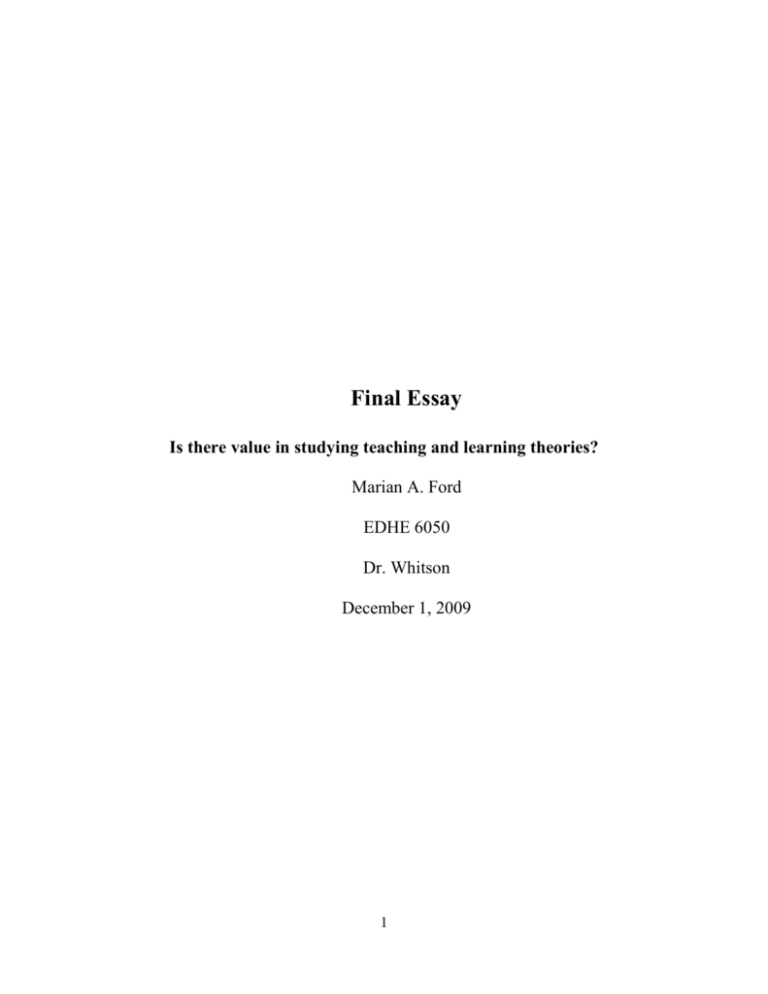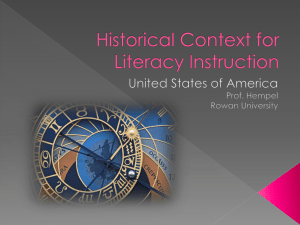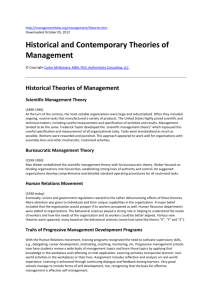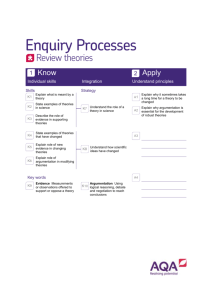
Final Essay
Is there value in studying teaching and learning theories?
Marian A. Ford
EDHE 6050
Dr. Whitson
December 1, 2009
1
Throughout the semester we have discussed and evaluated many learning theories
and methods in order to determine whether any of them or a combination of them in the
classroom helps us understand how students learn most effectively.
Learning occurs in
a variety of ways and individuals learn in their own way as a result of their experiences,
personalities and challenges they face throughout the learning process. In order to
determine whether there is value in studying learning theories we have to fully
understand the different theories, where they originated, and test them through
instruction. Some theories are based on behaviorism and some on neuroscience and
development of the brain, while others are just based on experimentation by theorists and
their observations. Teaching theories and the implications from instruction are
interwoven with learning theories. Learning theories shape teaching theories because
you will most logically teach what you believe or what has been proven through testing
to help students learn most effectively and successfully. Their implications address
organization, presentation, usage, activities, evaluation, assessment, and other methods
utilized in order to instruct in the best method that fosters learning.
Conditioning theories are those that explain learning due to the environment that
exists around learners. Operant conditioning (B.F. Skinner) is a behavioral theory that
examines the basic processes of reinforcement and punishment. Teachers use positive
and negative reinforcers all the time in the classroom in order to motivate students to
achieve their best performance. Behavior modification can also be used in order to adapt
learners’ negative habits into positive ones that contribute more successfully to their
learning. The most basic operant conditioning model is one that involves a stimulus, a
response and a reinforcing stimulus. In other words, a student is prompted by a precursor
2
activity; they behave in a certain way that might be positive or negative regarding their
learning and the teacher can provide appropriate consequences based on their actions.
Teachers can shape learners’ behavior and reinforce positive habits, traits and behaviors
in order to promote student achievement.
Constructivism is a philosophy of learning that is based on the assumption that
learners reflect on their experiences, and through these personal experiences, they
construct their own understanding of what is occurring around them. Learning is a search
for meaning in our environment, and the purpose of learning is for students to construct
their own meaning so they understand what they are learning. Student engagement with
their surroundings contributes to their learning through involvement with practical
knowledge, social learning, motivation, self efficacy and self regulation. Tinto believes
that education should adapt by allowing social and intellectual integration for the
development and success of student learning. The more students are involved in their
environment and they experience what they are learning, the more they will continue to
be involved; obtaining more concrete knowledge that is applicable and that makes sense
to them encourages further learning.
The experimental learning model, proposed by theorist David Kolb, assumes that
all learners must go through four modes of learning. Concrete experiences, reflective
observation, abstract concepts and active experiment are the four modes that continually
work through each new experience of a learner. The modes are infinite but restricting if
we are to assume that every learner goes through each mode in the same sequence or
pattern. The role learners’ experiences play in their learning process contributes to their
self awareness, motivation and self efficacy. A learner’s self efficacy is his own beliefs
3
concerning his capabilities and his ability to organize and incorporate the actions needed
in order to learn or perform at certain levels necessary for development, learning and
growth.
Social cognitive learning theory assumes students learn from their social
surroundings. Dewy was a strong proponent of social learning and would arguably be a
strong advocate for project-based learning, learning communities and integrated teaching.
Learning occurs through actual performance and observing those around us in our
environment, according to this theory. Others provide learners with the information
needed to make their own observations, experiments and judgment about their personal
skills and strategies. Learners are encouraged to set goals and assess their own progress
because they learn not only by watching and interacting with those around them but also
by applying the knowledge to their own experiences.
Vygotsky’s theory is central to the constructivist theory because of the emphasis
he placed on the role of social mediation of knowledge construction. Constructivism is
epistemology or the branch of philosophy that is concerned with the value and nature of
learning. People are active learners, and as the social cognitive theory explored, must
become involved with their surroundings and experiences in order to acquire knowledge.
This is why constructivism encourages or promotes integrated instruction where the
students become actively involved through field trips, internships or study exchange
programs. Vygotsky believed that humans, unlike animals, have the capacity to alter the
environment for their own benefit of learning. Interpersonal, cultural and historical and
personal individual factors are keys to human development. For example, the cultural
transmission of language through a study abroad program not only helps students become
4
stronger masters of the language of another culture, but it also helps them acquire a
greater cultural awareness.
Motivation was a topic covered throughout the reading, in a presentation and in
our discussions. A teacher’s expectations for students often relate to the teacher actions
and student achievement outcomes. Higher teacher expectation makes a student work
harder to meet that level of expectation and, therefore, he might learn more knowledge or
become more motivated to acquire a stronger skill established in that area. A student’s
achievement will begin to reflect the teacher’s expectations, and positive interaction and
encouragement by teachers through instruction help students maintain a positive desire to
learn. There is the current realization that low expectations are a big problem. Also, the
expectations are sometimes too low for students in developmental courses. The key is
the right amount of challenge and the right amount of support at the right time.
Brain-based learning is a learning theory that is based on the structure and
function of the actual brain. Everyone has the ability to learn, but the type of instruction
used could inhibit certain students to learn at a different rate or capacity as others. The
development of the brain and neuroscience of learning has a significant impact on which
learning activities are the most effective for students. Learning theories investigate the
question: what can make learning more enjoyable, more effective and more practical to
using our brain for what it was designed to do?
Human development as it relates to learning and learning theory is an important
educational issue because the two are so closely linked. Many theories recognize that
knowledge is a function of the learner’s experiences. Several other issues that are
addressed in the textbook are nature versus nurture, stability verses change, continuity
5
versus discontinuity, passivity versus activity, and structure versus function.
Development can depend on the environment of the individual, but does it have
more weight than an individual’s heredity that could contribute to his limits to learning?
There is also discussion about whether development must occur at certain stages in an
individual’s life and if it goes through small changes instead of through growth spurts
such as our physical transformation and maturity. Theories that stress learner activity
believe that students can be taught self regulation and independent learning, perhaps
through engagement activities, and, therefore, they can be more active in their own
development. Several developmental processes include biological (states that are
determined by genetics), psychoanalytic (changes in personality due to need satisfaction),
behavioral changes, cognitive changes, and contextual changes (social and cultural
factors can affect development).
Motivation is often affected based on a learner’s development, beliefs, values and
goals related to his performances and choices. As learners develop, motivation can
become more differentiated and complex, and as their brain develops, they become more
aware of the influences around them and their levels of motivation can begin to change.
The interaction between teachers and students should reflect developmental changes
because motivation helps learning as evidenced throughout all of the theories we
discussed.
Gagne’s instructional theory emphasizes the conditions of learning and the
circumstances that occur when learning happens. The types of learning outcomes are
intellectual skills, verbal information, cognitive strategies, motor skills, and attitudes.
Research indicates that the more teachers plan and base their decision-making on learning
6
models, the more effective their methods become. If Gagne’s theory or any instructional
teaching theory did not line up with the learning process, then it would be irrelevant to
adapt them to the classroom. If learning theories prove to be effective to students’
knowledge attainment, motivation, engagement and skill enhancement, then it is to the
learner’s benefit that teachers model instructional theories to these learning theories. I
believe that is the core of what Gagne’s theory as well as other instructional cognitive
theories provides.
The book facilitated or directed the discussions and topics throughout the semester,
but I felt the most beneficial aspect of the class was the variety of topics discussed in
presentations and in classroom interaction. Student interaction and engagement not only
help stimulate the brain but they also help us better understand information because we
are invested and participants in discussions about real life experiences occurring in our
secondary and higher education institutions. The reality that I took away the most
information from the discussions and presentations only validated for me several of the
learning theories discussed throughout the course. Social learning, in fact, helped me
understand, retain, and remain engaged in the subject matter.
The world is changing everyday and the education system must adapt its learning
applications, theories, instruction, and technology in order to mirror real world
experiences for learners to be successful outside of the classroom. Learning is a
continuous process and the human brain develops at different stages, but we never stop
acquiring new information or learning new things throughout our lifetime. The stronger
our ability to reflect, adapt and recognize and apply the knowledge that we gain, the more
efficiently and effectively we all learn. Creative learning and humor in learning, as was
7
discussed by fellow classmates, and project based learning in secondary institutions are
examples of instructional changes in education. These are all tools used to engage and
motivate learners in order to facilitate learning; they are based on theories, experiments,
actual data and successful programs and implementation of instruction based on the
learning theories we discussed.
Is there value in studying teaching and learning theories? I believe that most theories
can be utilized as building blocks for developing instructional learning techniques and
processes in the classroom. Although some theories may have originated long ago and
based on one individual’s experiences, they can be utilized today and adapted to reflect
the changes in education and the world today. For example, because of the rapid
advances in technology and its omnipresence in the classroom as an effective and
necessary learning tool, its need cannot be ignored. Instead, teachers must evaluate
learning theories and adapt their instructional techniques based not only on those theories
that provide relevant facts and successful results but also on those that change with the
evolution of learning. Individuals learn in countless ways unique to their development,
personality, environment and involvement; cognitive, social and behavioral theories can
help learners and teachers alike recognize the most effective learning tools their students
need. Everyone has the ability to learn; it’s the mode, speed, and desire that teachers
employ to help their students learn successfully.
8
References
1. Schunk, D. H. (2008). Learning theories: an educational perspective. Upper
Saddle River, NJ: Pearson Prentice Hall.
9







